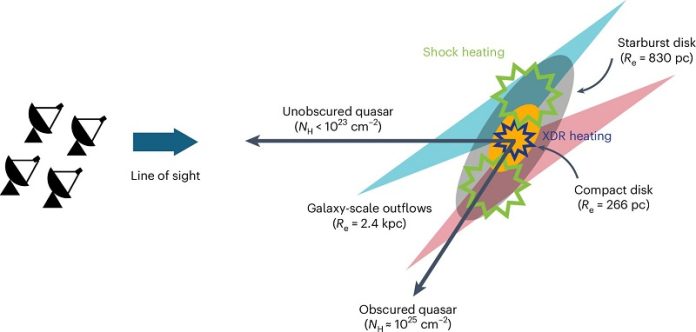
A new discovery has given scientists a powerful way to find hidden black holes across the universe.
An international team of researchers, including scientists from The Australian National University (ANU), has detected radio signals from hot gas around a supermassive black hole that existed 12.9 billion years ago.
Their findings were recently published in Nature Astronomy.
This is the closest look ever at the hot gas surrounding a black hole from such an early time in the universe’s history.
The discovery helps us better understand how black holes grow and why many of them might be hiding behind thick clouds of dust.
The research team, led by Professor Ken-ichi Tadaki from Hokkai-Gakuen University, used ultra-detailed observations from the ALMA (Atacama Large Millimeter Array) telescope.
They studied a supermassive black hole that is over a billion times heavier than our sun.
Dr. Takafumi Tsukui from ANU, one of the study’s co-authors, said this research changes how we search for black holes in the early universe.
“This helps us learn how tiny black holes grew into the supermassive ones we see today,” Dr. Tsukui said. “It also shows that many of these early black holes could still be hiding behind dust, invisible to current tools.”
Black holes are known for producing enormous energy as they pull in nearby matter. This energy powers quasars, which are some of the brightest objects in space. But even though they are bright, the inner areas near distant quasars are hard to study because they’re hidden by dust and gas.
Thanks to ALMA’s radio wave technology, scientists were able to see through the dust. They looked at special radio signals given off by carbon monoxide gas close to the black hole. These signals showed that the gas was heated by powerful X-rays, fast winds, and shock waves—much more extreme than in normal galaxies, where stars are the main source of heat.
“Because radio waves can pass through dust, our method is a great tool for finding black holes that were hidden before,” said Dr. Tsukui.
The team now plans to use this method to study more black holes and uncover how they formed and evolved in the early universe.
“This is a breakthrough,” Dr. Tsukui added. “By focusing on radio signals from certain molecules, we can now explore the areas closest to black holes—even ones hiding in the distant past.”
Source: Australian National University.



